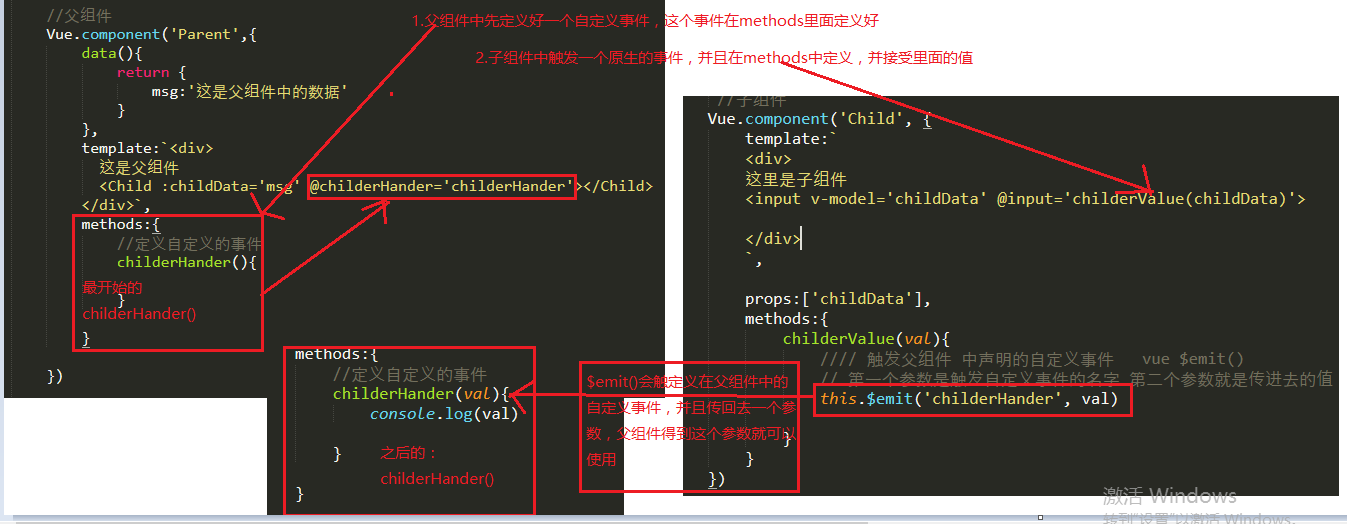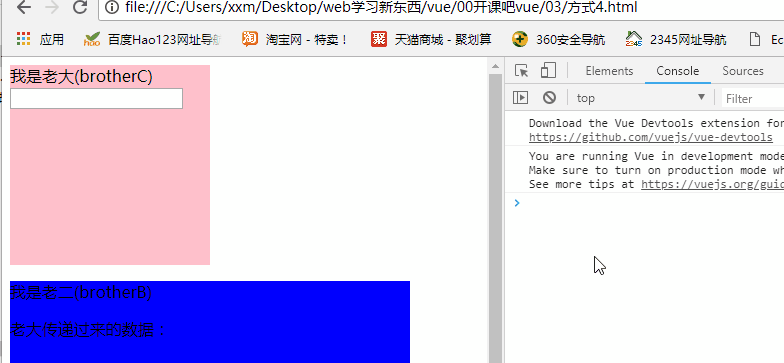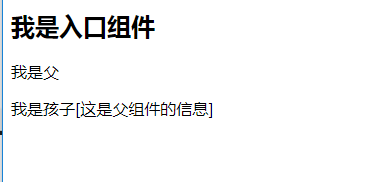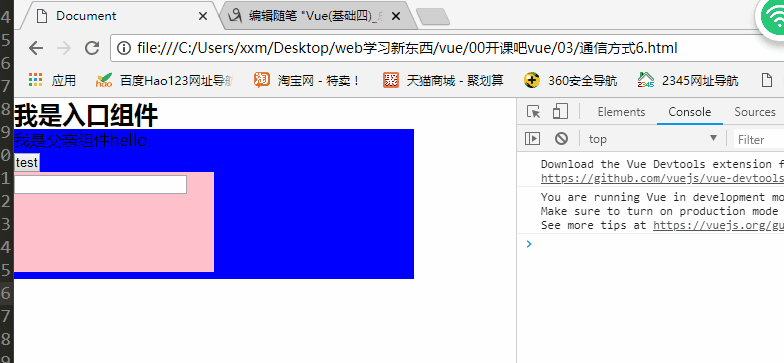Vue(基础四)_总结五种父子组件之间的通信方式
一、前言
这篇文章主要总结了几种通信方式:
1、方式一:使用props: [ ]和$emit() (适用于单层通信)
2、方式二:$attrs和$listeners(适用于多层)
二、主要内容
(1)父组件向子组件通信
a.步骤:①先给父组件添加自定义属性
②子组件用props:[]接收传来的自定义属性
③子组件就可使用接收到的数据
b.代码如下:

<!DOCTYPE html> <html lang="en"> <head> <meta charset="UTF-8"> <title>Document</title> <style type="text/css"> *{ margin:0; padding: 0; } .parent{ height: 150px; width: 400px; background-color: blue; } .child{ height: 100px; width: 200px; background-color: pink; } </style> </head> <body> <div id='app'> </div> <script type="text/javascript" src="node_modules/vue/dist/vue.js"></script> <script type="text/javascript"> Vue.component('Child',{ data(){ return{ } }, template:`<div class='child'> 这是孩子组件 <input :value='childData'/> </div>`, props:['childData'] }) var Parent = { data(){ return{ msg:'这是父组件的数据' } }, template:`<div class='parent'> 这是父组件: <Child :childData='msg'></Child> </div> ` } new Vue({ el:"#app", data(){ return{ } }, template:`<Parent></Parent>`, components:{ Parent } }) </script> </body> </html>
c.测试结果:孩子组件接收到了父组件的数据,并且显示在孩子组件的input框里

d.具体实现:

(2)子组件向父组件通信
步骤:①现在父组件中定义自定义事件
②子组件中定义一个原生的事件,调用下面methods中定义的
③在子组件的method()中定义一个事件,用$emit(),来触发父组件的事件,
代码如下:

<!DOCTYPE html> <html lang="en"> <head> <meta charset="UTF-8"> <title>Document</title> <style type="text/css"> *{ margin:0; padding: 0; } .parent{ height: 150px; width: 400px; background-color: blue; } .child{ height: 100px; width: 200px; background-color: pink; } </style> </head> <body> <div id='app'> </div> <script type="text/javascript" src="node_modules/vue/dist/vue.js"></script> <script type="text/javascript"> Vue.component('Child', { data(){ return{ childData:'孩子' } }, template:`<div class='child'> 这是孩子组件 <input v-model='childData' @input='childerValue(childData)'/> </div>`, methods:{ childerValue:function(val){ this.$emit('childerHander', val) } } }) var Parent = { data(){ return { msg:'' } }, template:`<div class='parent'> <Child @childerHander='childerHander'></Child> </div>`, methods:{ childerHander:function(val){ console.log(val) } } } new Vue({ el:'#app', data(){ return{ } }, template:`<div> <Parent></Parent> </div>`, components:{ Parent } }) </script> </body> </html>
测试:

具体实现:

-------------------------------------------------------------------------------------------------------------------------------------------------------------------
第一种方式适合用于单层嵌套的情况,如果组件中有三层嵌套如果用第一种那么需要在每个子组件中定义props:[]接收,这样实现起来比较麻烦,在vue2.4开始提供了$attrs和$listeners来解决这个问题
能够让组件A之间传递消息给组件C
如下所示:

代码如下:

<!DOCTYPE html> <html lang="en"> <head> <meta charset="UTF-8"> <title>Document</title> <style type="text/css"> .a{ width: 400px; height: 400px; background-color: blue; } .b{ width: 300px; height: 300px; background-color: orange; } .c{ width: 200px; height: 200px; background-color: pink; } </style> </head> <body> <div id='app'> </div> <script type="text/javascript" src="node_modules/vue/dist/vue.js"></script> <script type="text/javascript"> //定义组件cc Vue.component('C',{ data(){ return{ } }, template:`<div class='c'> 这是c组件 <div>{{$attrs.messagec}}</div> </div>` }) Vue.component('B',{ data(){ return{ } }, template:`<div class='b'> <C v-bind='$attrs'></C> </div>` }) //定义组件A Vue.component('A', { data(){ return{ } }, //1.先接收 props:['message'], template:`<div class='a'> <B v-bind='$attrs'></B> </div>` }); //定义组件App----A var App = { data(){ return{ msg:'我是父组件的内容', messagec:'helloc' } }, template:`<div> 这是一个父组件 <A :messagec='messagec'></A> </div>` } new Vue({ el:'#app', data(){ return{ } }, components:{ App }, template:'<App />' }) </script> </body> </html>
测试:

具体实现:

(2)子组件向父组件传递信息

<!DOCTYPE html> <html lang="en"> <head> <meta charset="UTF-8"> <title>Document</title> <style type="text/css"> .a{ width: 400px; height: 400px; background-color: blue; } .b{ width: 300px; height: 300px; background-color: orange; } .c{ width: 200px; height: 200px; background-color: pink; } </style> </head> <body> <div id='app'> </div> <script type="text/javascript" src="node_modules/vue/dist/vue.js"></script> <script type="text/javascript"> //定义组件cc Vue.component('C',{ data(){ return{ } }, template:`<div class='c'> 这是c组件 <input @input='cClickHandler' /> </div>`, methods:{ cClickHandler(){ alert(1) this.$emit('getCData','这是c的数据') } } }) Vue.component('B',{ data(){ return{ } }, template:`<div class='b'> <C v-on='$listeners'></C> </div>` }) //定义组件A Vue.component('A', { data(){ return{ } }, //1.先接收 props:['message'], template:`<div class='a'> <B v-on='$listeners'></B> </div>` }); //定义组件App----A var App = { data(){ return{ msg:'我是父组件的内容', messagec:'helloc' } }, template:`<div> 这是一个父组件 <A v-on:getCData='getCData'></A> </div>`, methods:{ getCData(val){ console.log(val) } } } new Vue({ el:'#app', data(){ return{ } }, components:{ App }, template:'<App />' }) </script> </body> </html>
测试如下:

具体实现:

----------------------------------------------------------------------------------------------------------------------------------------------------------------------------------------------------------------
方式三:上面两种方式都是父子组件之间数据的传递,如果两个组件不是父子关系呢?这种情况下可以使用中央事件总线的方式,新建一个Vue事件bus对象,然后通过bus.$emit触发事件,bus.$on监听触发的事件
例子如下:

代码如下:

<!DOCTYPE html> <html lang="en"> <head> <meta charset="UTF-8"> <title>Document</title> <style type="text/css"> .brotherB{ width: 400px; height: 400px; background-color: blue; } .brotherC{ width: 200px; height: 200px; background-color: pink; } </style> </head> <body> <div id='app'> </div> <script type="text/javascript" src="node_modules/vue/dist/vue.js"></script> <script type="text/javascript"> //中央事件总线 var bus = new Vue(); //B->C传事件 Vue.component('brotherC', { data(){ return{ msg:'hello brotherB' } }, template:`<div class="brotherC"> 我是老大(brotherC) <input type='text' v-model='msg' @input='passData(msg)'/> </div>`, methods:{ passData(val) { bus.$emit('globalEvent',val) //去触发 } } }); Vue.component('brotherB', { data(){ return{ brother2Msg:'' } }, template:`<div class="brotherB"> <p>我是老二(brotherB)</p> <p>老大传递过来的数据:{{brother2Msg}}</p> </div>`, //首先给brotherB绑定一个全局的事件 mounted(){ bus.$on('globalEvent', (val)=>{ this.brother2Msg = val;//这里用箭头函数,避免避免this改变 }) } }); var App = { data(){ return{ msg:'我是父组件的内容' } }, template:`<div> <brotherC></brotherC> <brotherB></brotherB> </div>` } new Vue({ el:"#app", data(){ return{ } }, template:'<App/>', components:{ App } }) </script> </body> </html>
演示效果如下:

具体实现:

------------------------------------------------------------------------------------------------------------------------------------------------------------------------------------------------
方式四:父组件中通过provide来提供变量,然后在子组件中通过inject来注入变量,不论子组件有多深,只要调用了inject那么就可以注入provider中自定义的属性,而不只仅仅是从prop中接受到的数据,只要在生命周期内,子组件都可以调用

<!DOCTYPE html> <html lang="en"> <head> <meta charset="UTF-8"> <title>Document</title> </head> <body> <div id='app'> </div> <script type="text/javascript" src="node_modules/vue/dist/vue.js"></script> <script type="text/javascript"> Vue.component('Child', { data(){ return { msg:'' } }, template:`<div> 我是孩子{{msg}} </div>`, //2.注入 inject:['for'], created(){ //3.拿到 this.msg = this.for } }) Vue.component('Parent', { template:`<div> <p>我是父</p> <Child /> </div>` }) var App = { data(){ return{ } }, //1。提供 provide:{ for:'[这是父组件的信息]' }, template:`<div> <h2>我是入口组件</h2> <Parent /> </div>` } new Vue({ el:"#app", data(){ return { } }, template:'<App/>', components:{ App } }) </script> </body> </html>
测试如下:

------------------------------------------------------------------------------------------------------------------------------------------------------------
代码实现:

<!DOCTYPE html> <html lang="en"> <head> <meta charset="UTF-8"> <title>Document</title> <style type="text/css"> .child{ width: 300px; height: 300px; background-color: pink; } .parent{ width: 500px; height: 500px; background-color: blue; } </style> </head> <body> <div id="app"></div> <script src="https://cdn.jsdelivr.net/npm/vue/dist/vue.js"></script> <script type="text/javascript"> Vue.component('Child',{ data(){ return{ mymessage:'' } }, template:`<div class="child"> <input type="text" v-model="mymessage" @input='changeValue'/> </div>`, methods:{ changeValue(){ this.$parent.message = this.mymessage } } }) Vue.component("Parent",{ data(){ return{ message:"hello" } }, template:`<div class="parent"> <p>我是父组件{{message}}</p> <Child></Child> </div>`, methods:{ } }) var App={ data(){ return{ } }, template:`<div> <h2>我是入口组件</h2> <Parent /> </div>` } new Vue({ el:"#app", data(){ return{ } }, template:`<App />`, components:{ App } }) </script> </body> </html>

<!DOCTYPE html> <html lang="en"> <head> <meta charset="UTF-8"> <title>Document</title> <style type="text/css"> *{ margin:0; padding: 0; } .parent{ height: 150px; width: 400px; background-color: blue; } .child{ height: 100px; width: 200px; background-color: pink; } </style> </head> <body> <div id='app'> </div> <script type="text/javascript" src="node_modules/vue/dist/vue.js"></script> <script type="text/javascript"> Vue.component('Child', { props:{//子组件通过props接收父组件的value props:[]也可以 value:String, }, data(){ return{ mymessage:this.value //将上面的this.value赋值给mymessage } }, template:`<div class='child'> <input type="text" v-model='mymessage' @input='changeValue' /> </div>`, methods:{ changeValue(){//通过$parent将子组件的信息传递给孩子 this.$parent.message = this.mymessage; console.log(this.$parent) } } }) Vue.component('Parent',{ //当点击之后, template:`<div class='parent'> <p>我是父亲组件{{message}}</p> <button @click='changeValue'>test</button> <Child></Child> </div>`, methods:{//通过$chidren[0]传递给孩子 changeValue(){ this.$children[0].mymessage = 'hello' } }, data(){ return { message:'hello' } } }) var App = { data(){ return{ } }, template:`<div> <h2>我是入口组件</h2> <Parent/> </div>` } new Vue({ el:"#app", data(){ return{ } }, template:'<App/>', components:{ App } }) </script> </body> </html>
测试:

三、总结
1、常用的方式是前三种




